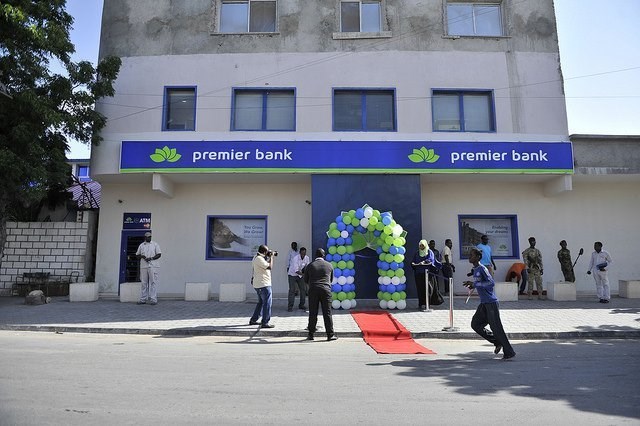
Sunday March 31, 2019

A branch of Somalia's Premier Bank. Kenyan banks are eyeing Somalia as a new regional Market. FILE
NAIROBI, March 30 (Xinhua) -- Kenyan largest banks have overcome a
controlled interest rate environment to make billions of shillings in
profits for the third year in a row as they eye Ethiopian, Somalia and
Democratic Republic of Congo (DRC) markets.
At least seven banks have so far released their 2018 performance,
with the results showing that the financial institutions have triumphed
over the effects of the law introduced in September 2016.
Some of the banks that have released their financial results in the
last weeks are Kenya Commercial Bank (KCB), Equity Bank, Diamond Trust
Bank (DTB), Standard Chartered Bank (SCB), Cooperative Bank, Barclays
Bank and NIC Bank.
Equity Bank's profit stood at 19.8 billion shillings (198 million
U.S. dollars) in 2018, up from 189 million dollars in the previous year.
Similarly, for Cooperative Bank, profits rose to 182 million dollars,
up from 164 million dollars while DTB profits increased to 110 million
dollars.
KCB has announced the biggest profits so far, raking in 240 million dollars in 2018.
According to analysts, the banks' huge profits are a result of their
increased lending to government as opposed to the private sector.
The seven banks advancement to the government in 2018 stood at over
100 million dollars, an increase of 12 percent year-to-year, an analysis
of the financial results shows.
"Banks continued to invest in government securities, which offer
better risk-adjusted returns. Interest income from the sector increased
by 5.4 percent," Cytonn, a Nairobi investment firm, said in a brief on
Saturday.
On the other hand, average loan growth to private sector remained
anemic, coming in at 2.8 percent in 2018, lower than 6.1 percent
recorded in 2017, an indication of slower credit extension to the
economy.
Ernest Manuyo, a business management lecturer at Pioneer Institute in
Nairobi, noted that banks' huge profits show the capping of interest
rates is behind them.
"The biggest casualties of the law have been Kenyans, the very people
it was supposed to protect. Banks have tightened their purses to the
private sector but opened them up to the government protecting their
profits as their results show. It is a good thing the court has done way
with the caps," he said.
A fortnight ago, Kenyan high court ruled that interest rate capping
was unconstitutional and asked parliament to amend them in 12 months.
While many saw this as a huge win for Kenyan banks, the realities in
the industry show that doing away with the law is perhaps what the
private sector too need to.
Huge profits realized in Kenya have made the top banks look beyond
the East Africa Community market, with KCB and Equity Bank eyeing
Somalia, DRC and Ethiopia.
KCB, which is the biggest bank in Kenya, revealed that it is eyeing the Somalia, DRC and Ethiopian markets.
"It is a restricted market but there are reforms going on. We have
held talks and we are hoping they will allow Kenyan banks," said the
bank's chief executive Joshua Oigara recently.
Ethiopia with a population of 100 million, the second largest in
Africa after Nigeria, has less than 15 percent banked people, creating
huge opportunities for regional banks.
Equity Bank, which is operating a subsidiary in DRC, is also eyeing the Somali and Ethiopian markets.
The bank is already in talks with six Ethiopian banks to facilitate
cross-border mobile and e-commerce payments before it moves to set shop
in the country.
Kenyan banks' entry into the Somali market will however be hindered
by the lack of proper government structures on the registration of
persons, which makes the implementation of international regulations on
terror financing prevention difficult, according to Cytonn.